Handling the all-American black bear encounter
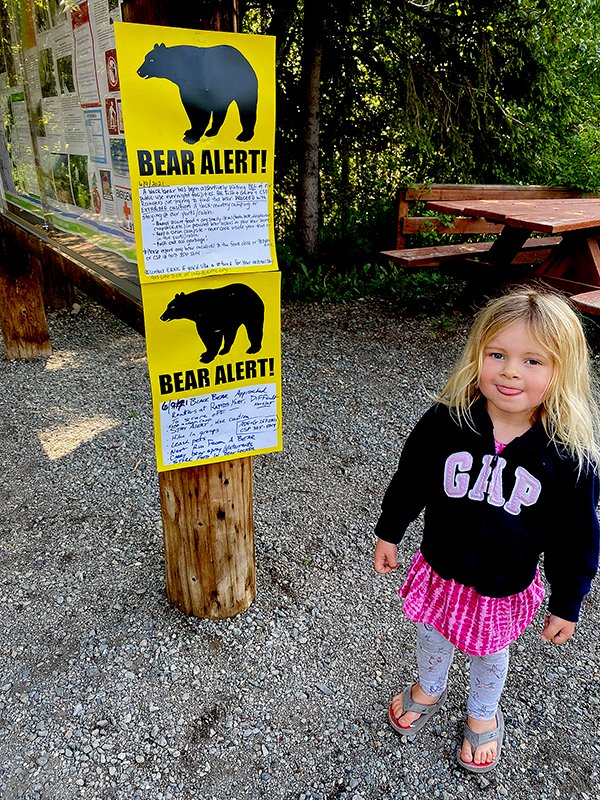
by Tim Lesmeister
I spend my summers on Madeline Island in northern Wisconsin these days. It’s the only island in the Apostle Islands chain with permanent dwellings. All the other islands are managed by the U.S. Forest Service and not open to development.
The town of La Pointe sits on the west end of Madeline Island and greets people as they exit the ferry and drive or walk off to enjoy the restaurants and shops. There is a marina and an 18-hole golf course. The state of Wisconsin has a beautiful state park with camping, and there is a town park with campsites, too. Both parks sit on a long swatch of beautiful sand beach that gets smoothed by the waves of Lake Superior’s crystal-clear water.
Madeline Island has a wealth of wildlife. There are deer, fox, coyotes, many types of birds, fishers, mink, otter, and a burgeoning population of black bear.
I was sitting with a group of people at the golf course recently watching a doe and her two fawns wander through a flock of geese that were pulling at the fairway grass. The conversation had us sharing the stories of bears that were showing up on our properties. One couple living right in town had two cubs, a 2- or 3-year-old and the mother, a big sow, all wandering around the house. The sow entered the screen porch, looked in the window, and then wandered back out into the yard.
My next-door neighbor’s dog recently treed a huge black bear. Now this dog barely weighs 40 pounds, but he sent that big bear up a huge pine and held it there until being pulled off.
I have a 2-year-old bear wandering around on my property. He likes to nap in a clearing just a few hundred feet to the east of my house. My next-door neighbor’s beagle will chase him into my woods when the two meet, but that little dog doesn’t intimidate that young bear enough to get him to climb a tree.
With all these bear meet human connections, it’s amazing there are no negative encounters that result in an aggressive bear mauling a dog, or worse, attacking a human. Is it just luck, or are the bears on Madeline Island just conditioned to humans and dogs?
The answer is in the statistics. There is fewer than one black bear attack a year in the United States according to the National Park Service. Chances of being injured by a bear are one out of 2 million. Since the year 1900, there have only been 67 black bear fatalities in North America. That’s just one fatality every other year.
So black bears are shy and non-aggressive by nature. That doesn’t mean they aren’t capable of inflicting some major damage to a person if they want. Get between a momma and her cubs and see what happens. Wander up on a big boar that is eating on a fresh kill, and be prepared to see a mean animal. Certain conditions warrant caution when a bear is present.
I now carry pepper spray with me on the hiking trails on Madeline Island. I keep that one eye in the back of my head wide open all the time, paying close attention to what surrounds me in the woods. I’m staying on high alert no matter where I’m standing these days whether it be in my backyard or on a trail in the middle of the woods. When you are in bear country, it pays to be diligent, even if the bears seem friendly.
Turkey hunters,
it’s never too early to strategize

by Mike Raykovicz
Here it is, late March and I’m getting antsy about the upcoming turkey season. May 1 is only a few weeks away but, I’m already planning my hunting strategy. Years ago, a national outdoor magazine featured an article entitled “Ten Rules for Finding Fall Turkeys.” The first rule stated, “find the flock.” When my friend and I saw the article, I looked at him and said, “if we could find the flock we wouldn’t need the other nine rules.” We laughed at that for years until he passed away a short while ago.
As the article stated if you’re going to hunt turkeys you have to know where they are. Weather permitting, my spring scouting begins in mid-April and if I’m going to hunt an area, I want to make sure there are turkeys there. If the weather is rainy, I’ll drive around the back roads bordering the properties I hunt with a pair of binoculars at hand. At this time of year, hen gathering and mating are going on and if I see a group of turkeys it’s usually a mature tom or sometimes even several, traveling with their hen harem. I note the time of day I see them and how many toms I see.
If there is still snow on the ground I like to check various farm fields. The snow can tell me if turkeys are frequenting the area even if I don’t see or hear any. One of the farms I hunt is a dairy farm and I always take a walk around the property and check for scratchings or droppings. It’s easy to tell male from female turkey droppings because a tom’s is “J-shaped” while a hen’s is spiral in shape much like the curl on a soft ice cream cone. I pay careful attention to these farm areas, especially those where manure has been spread. Turkeys can’t seem to resist a “hot lunch” and may regularly feed on the undigested corn and other grain passed in the cow manure and their presence can be easy to spot.
To determine where the birds may be roosting, I’ll get up early in the morning and just listen. I have a spot on one farm I hunt where I can hear any bird that gobbles even if he’s high on the hill or in the valley below. Later, in the days before the season opener, I’ll go back to that location and just sit and listen to determine where the birds are likely to be on opening day.
The one thing I don’t do is to use any turkey calls. The last thing I want to do is to have a mature tom come to my call before the season opens. If I don’t hear any birds sound off as daylight approaches, I’ll use an owl call and try to get a response. All I want to know is that there are birds in the area.
Setting a trail camera along a woodland road that winds through the woods is also a good tactic that often works for me. Turkeys seem to use these roads when they travel through hardwoods so, a trail camera can tip you off even on mornings when the birds don’t gobble.
Finally, just because I’m looking for turkey sign doesn’t mean I’m not on the lookout for new deer hunting locations. Trails or rubs I may have missed in September or October are easy to spot now and I’m always evaluating these spots for their potential as a bowhunting site. I’ve often said you don’t have to be a good caller to bag a spring tom but, you just have to be a good scouter.
Varying weather patterns perplexing snow geese
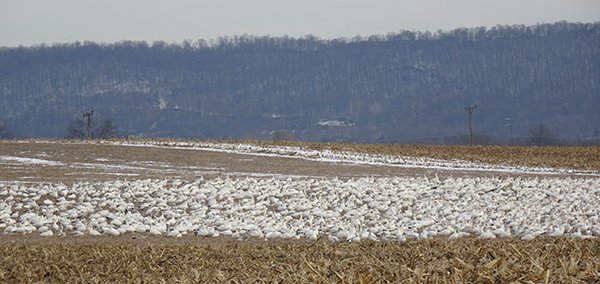
by Ron Steffe
Late last week, while traveling to a nearby farm to gather some spilled corn cobs that were left during the fall harvest, mainly for the birds and squirrels that visit my homes bird feeders, I spotted a huge flock of circling snow geese that were close to landing on another nearby farm.
When I had enough corn, I drove to where the geese were headed, spotted them grouped together, and snapped a couple of photos.
To see these birds locally in January is extremely rare. During many past seasons while laying well covered with companions amongst a big spread of Canada goose decoys we often spotted huge flocks of snow geese headed south. Most often this was before Thanksgiving, and I can recall one particular Thanksgiving morning when a flock of the white birds circled above our spread, almost reaching shotgun range before they decided to depart and continue their southward journey.
Any thoughts of snow geese when we saw them in November were pointed toward their return from winter grounds that usually occurs in late February into the first half of March. We knew when January came it was still Canada geese we hunted, and snow geese were always long past us by then, their return at least a month away.
Beyond any logical reason for this rarity is the pattern of the weather. Warm conditions this past year remained in Canada and upper New York state for a prolonged period. Snow cover just wasn’t a problem because virtually none existed. Both of these factors allowing for open water roosting and easy food access for this species of fowl.
Even at this moment there remains a good number of snow geese locally, spending their nights in the open water of a local quarry hole, and feeding on spent corn in nearby fields where snow cover is spotty.
Add the fact that big flocks of these spectacular birds flying high, are still passing at certain times heading to the mid-Atlantic coast where they spend the winter. This is something I personally never have seen in the past during January.
I spend a lot of time outdoors hunting, fishing and photographing wildlife and where they live. And the more time I spend outside the more I’ve witnessed the reactions of wild creatures and wild places to a warming planet.
I know many believe that not to be true, and many just seem to be so thoroughly knotted into their everyday lives to even consider this quandary facing the Earth.
But damn, with snow geese flying south in January, something is wrong.
Southern Minnesota bowhunter arrows a 9-pointer hauling a mess of fence.
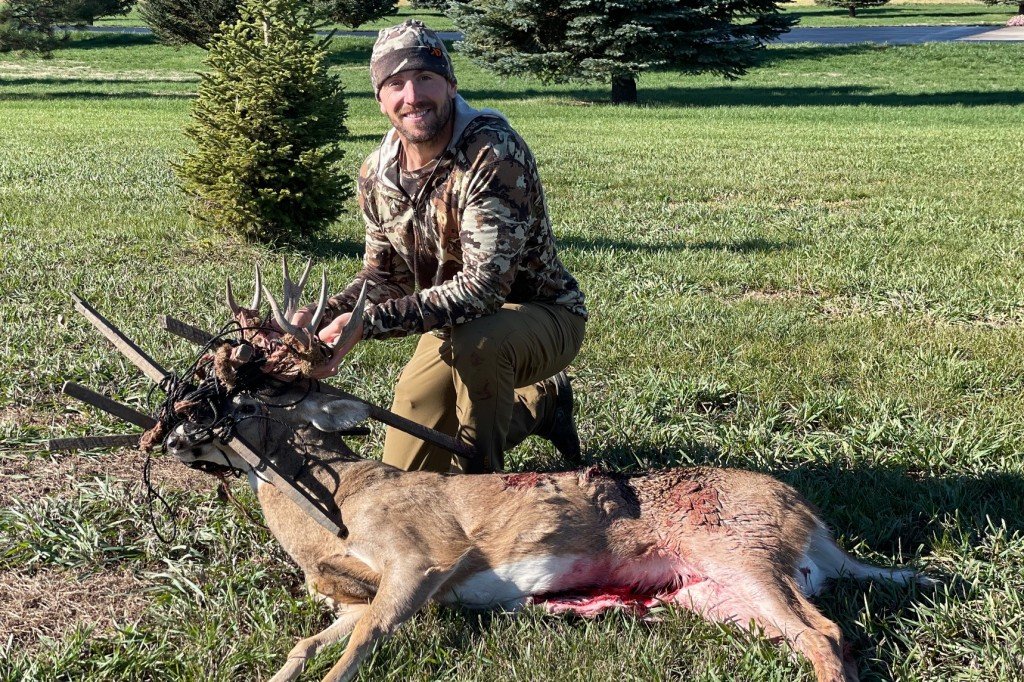
As the sun came up on a calm, crisp Oct. 23 morning, I had been watching two small bucks sparing about 100 yards from me for about a half hour. One of them split off and started to head my way eventually reaching the food plot in front of my bow stand on a piece of private land.
I was watching him feed on turnips and hit a licking branch when out of the corner of my eye this buck stepped out into the open on the south end of the food plot. I did a double take as I noticed something unusual in his rack.
I put my binoculars on him and realized he had a whole mess of fencing wrapped around his head. Upon closer examination, I recognized the deer as a split G2 buck that my brother and I had trail camera pictures of and was one that definitely had some potential to grow into a nice buck.
As the buck made his way into the food plot, I had my mind set on not shooting this deer. As I observed him and he got closer, however, I could tell the deer was not acting normal. He was breathing heavy and didn’t have any interest in feeding in the plot.
He eventually worked his way into 25 yards and stood behind a cedar tree. I did not have a shot, but his pausing gave me more time to evaluate the deer. My instincts told me that this deer was in bad shape.
He looked lethargic and continued to breathe heavily. The smaller buck worked his way over and was interested in sparing some more, but this 9-pointer didn’t have any interest in expending that kind of energy.
I knew I needed to harvest this buck. Letting him walk away meant his certain death was going to be long and painful. After about 10 minutes, he began to exit the food plot heading for the thicket by the river. I had about a 20-yard gap between two cedar trees that would provide my only shooting lane.
As the buck stepped into that opening I ranged him at 38 yards. I drew my bow as he continued to walk slowly through the switch grass. Just before he reached the second cedar, I let out a short grunt. He stopped and turned his head towards me.
One of the fence posts was hanging down covering part of his front shoulder so I took aim further back hoping for a lung shot. The arrow ripped through the air finding its mark and completely passing through the deer. I could tell it was a good shot as the buck bounded off and out of sight.
I sat in my stand for 20 minutes waiting for the after-shot shakes to subside. Eventually, I crawled out of my stand, found the arrow covered in blood, and saw a very distinct blood trail.
Confident that the buck was just up the trail, I brought my two nieces out to help with the track job. The excitement was high for a 6- and a 3-year-old as it was their first time tracking a deer. We stomped through the thick woods following one of the easiest blood trails I’ve ever seen.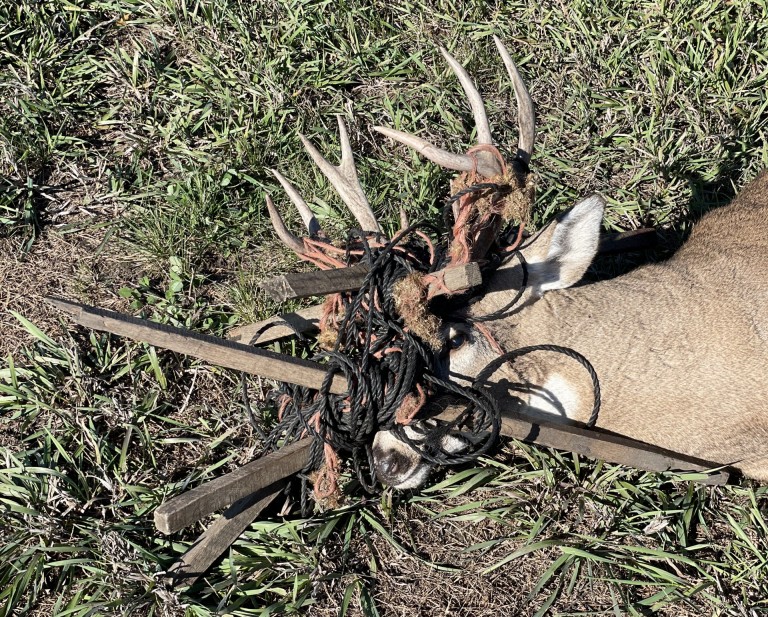
Not even 60 yards from the shot, the girls spotted the buck piled up in a tree. It was a proud moment for me introducing my nieces to my hunting passion.
Examining the deer and the mess that was on his head, I noticed that he had rope around his neck and in his mouth. I felt a huge sense of relief knowing I made the right decision and gave this deer the quickest and least painful death possible.
We’d seen this buck 12 days earlier via our trails cams, so I know the entanglement had happened within that time period.
The situation is a reminder to all citizens to think before throwing fencing or any trash away in an area where these animals live. We can all do a better job of providing great wildlife habitat.
Maurer said the venison was in good shape from the deer, and he’s working with a taxidermist to have the buck mounted.
Using deer ‘communication centers’ to your advantage all year
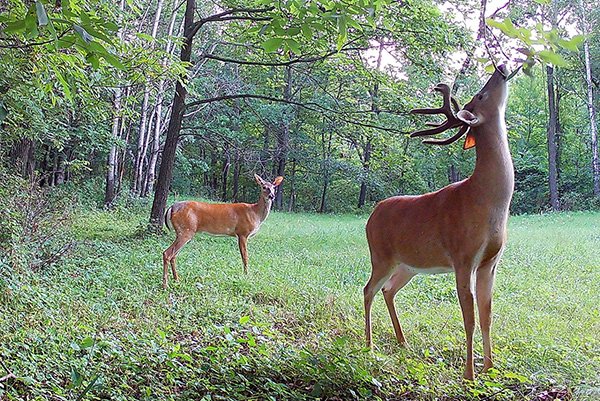
by Jerry Davis
Wildlife biologists remind us that even does and fawns, as well as bucks, use scrapes for communication to some extent and throughout the year, too.
A trail camera, set up in a region where deer often create scrapes, captured two interesting images. First, a mature doe came through the area, stood under an overhanging tree, then stood on her hind legs to reach a chewed twig.
Two days later, Aug. 17, a mature buck, still in velvet, stood under the same tree and stretched his neck up to touch the same twig while he tangled his antlers through the leaves and twigs.
Several things are worthy to note here. This may be a location for a deer to acquire CWD, at any time of the year. Also, hunters, deer watchers, and photographers are likely to get a better idea of resident deer at these “communication” locations. And this location is likely to continue to be an even greater communication site during the hunting seasons.
It is possible to “read” this information from trail cameras equipped with ability to transfer data directly to a computer or phone miles away from the site. This will take some of the worry, real or imagined, out of disturbance by humans.

